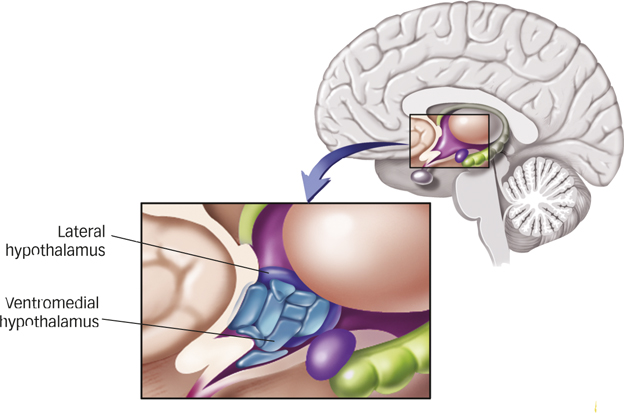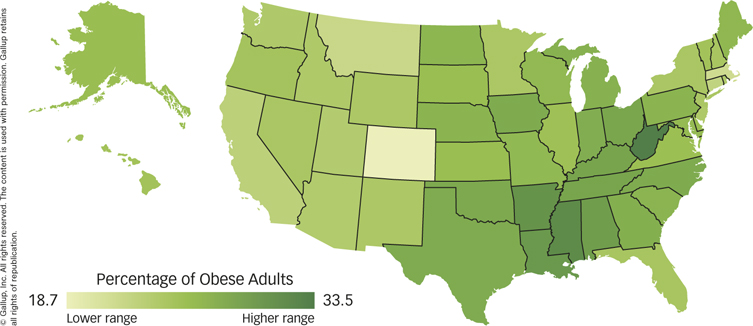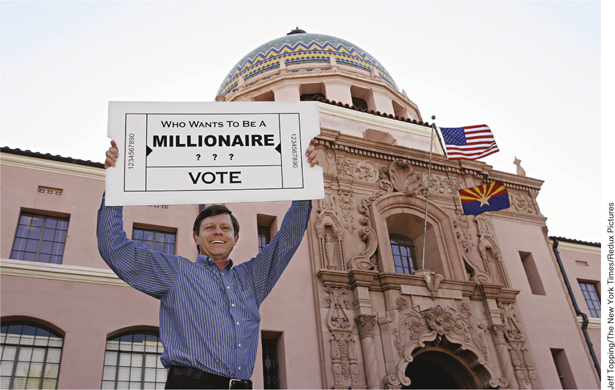8.3 Motivation: The Wanting Machine
Leonardo is a robot, so he does what he is programmed to do and nothing more. Because he doesn’t have wants and urges—
motivation
The purpose for or psychological cause of an action.
Biological Motivations
Humans are animals, and all animals must survive and reproduce. It is not surprising, then, that two of our most powerful biological motivations are toward food and sex. We are driven to make lunch and driven to make love, but as you will see, neither of these motivations is as simple as it sounds.
Survival: The Motivation for Food
When a thermostat detects that a room is too cold, it sends a signal that initiates a corrective action, namely, turning up the furnace. Bodies are a bit like thermostats in this way. To survive, the body must maintain precise levels of nutrition, warmth, and so on, and when these levels depart from optimality, the body sends signals to the brain, asking it to take corrective action. That signal is called a drive, which is an internal state that signals a physiological need.
drive
An internal state that signals a physiological need.
The most regular and familiar of your body’s drives is what you call hunger. At every moment, your body is sending signals to your brain about the amount of energy it has available. If your body needs energy, it sends a signal to tell your brain to switch hunger on, and if your body has sufficient energy, it sends a signal to tell your brain to switch hunger off (Gropp et al., 2005). No one knows precisely what these signals are or how they are sent and received, but research has identified a few candidates.
259
For example, ghrelin is a hormone that is produced in the stomach and appears to be one of the signals that tells the brain to switch hunger on (Inui, 2001; Nakazato et al., 2001). When people are injected with ghrelin, they become intensely hungry and eat about 30% more than usual (Wren et al., 2001). Another chemical called leptin is secreted by fat cells, and it appears to be one of the signals that tells the brain to switch hunger off, which makes food less rewarding (Farooqi et al., 2007). People who are born with a leptin deficiency have trouble controlling their appetites (Montague et al., 1997). Some researchers think this story is far too simple. They argue that there is no general drive called hunger, but rather, that there are many different hungers, each of which is a response to a unique nutritional deficit and each of which is switched on by a unique chemical messenger (Rozin & Kalat, 1971). For example, rats that are deprived of proteins will gladly eat proteins but will turn down fats and carbohydrates, suggesting that they are experiencing a specific “protein hunger” and not a general hunger (Rozin, 1968).
What makes us feel hungry?
Whether hunger is signaled by one chemical or many, the primary receiver of these signals is the hypothalamus (see FIGURE 8.10). The lateral hypothalamus receives the “hunger on” signals, and when it is destroyed, animals sitting in a cage full of food will starve themselves to death. The ventromedial hypothalamus receives the “hunger off” signals, and when it is destroyed, animals will gorge themselves to the point of illness and obesity (Miller, 1960; Steinbaum & Miller, 1965). These two structures were once thought to be the “hunger center” and “satiety center” of the brain, but it turns out to be much more complicated than that (Woods et al., 1998). These structures clearly play an important role in hunger, but no one yet knows exactly what the role is (Stellar & Stellar, 1985).


EATING DISORDERS. Feelings of hunger tell us when to start eating and when to stop. But for the 10 to 30 million Americans who have eating disorders, eating is a much more complicated affair (Hoek & van Hoeken, 2003). For instance, bulimia nervosa is an eating disorder characterized by binge eating followed by purging. People with bulimia typically ingest large quantities of food in a relatively short period and then take laxatives or induce vomiting to purge the food from their bodies. These people are caught in a cycle: They eat to ease negative emotions such as sadness and anxiety, but then concern about weight gain leads them to experience negative emotions such as guilt and self-
bulima nervosa
An eating disorder characterized by binge eating followed by purging.
Anorexia nervosa is an eating disorder characterized by an intense fear of being fat and severe restriction of food intake. People with anorexia tend to have a distorted body image that leads them to believe they are fat when they are actually emaciated, and they tend to be high-
anorexia nervosa
An eating disorder characterized by an intense fear of being fat and severe restriction of food intake.
Anorexia may have both cultural and biological causes (Klump & Culbert, 2007). For example, women with anorexia typically believe that thinness equals beauty (which isn’t a very surprising conclusion for women to draw when the average American fashion model is seven inches taller and 23 pounds lighter than the average American woman). But anorexia is not just “vanity run amok” (Striegel-
260
What causes anorexia?
OBESITY. America’s most pervasive eating-
|
|
Normal |
Overweight |
Obese |
Extreme Obesity |
||||||||||||||||||||||||||||||||
|---|---|---|---|---|---|---|---|---|---|---|---|---|---|---|---|---|---|---|---|---|---|---|---|---|---|---|---|---|---|---|---|---|---|---|---|---|
|
BMI |
19 |
20 |
21 |
22 |
23 |
24 |
25 |
26 |
27 |
28 |
29 |
30 |
31 |
32 |
33 |
34 |
35 |
36 |
37 |
38 |
39 |
40 |
41 |
42 |
43 |
44 |
45 |
46 |
47 |
48 |
49 |
50 |
51 |
52 |
53 |
54 |
|
Height (Inches) |
Body Weight (pounds) |
|||||||||||||||||||||||||||||||||||
|
58 |
91 |
96 |
100 |
105 |
110 |
115 |
119 |
124 |
129 |
134 |
138 |
143 |
148 |
153 |
158 |
162 |
167 |
172 |
177 |
181 |
186 |
191 |
196 |
201 |
205 |
210 |
215 |
220 |
224 |
229 |
234 |
239 |
244 |
248 |
253 |
258 |
|
59 |
94 |
99 |
104 |
109 |
114 |
119 |
124 |
128 |
133 |
138 |
143 |
148 |
153 |
158 |
163 |
169 |
173 |
178 |
183 |
188 |
193 |
198 |
203 |
308 |
212 |
217 |
222 |
227 |
232 |
237 |
242 |
247 |
252 |
257 |
262 |
267 |
|
60 |
97 |
102 |
107 |
112 |
116 |
123 |
128 |
133 |
138 |
143 |
148 |
153 |
156 |
163 |
168 |
174 |
179 |
184 |
189 |
194 |
199 |
204 |
209 |
215 |
220 |
225 |
230 |
235 |
240 |
245 |
250 |
256 |
261 |
266 |
271 |
278 |
|
61 |
100 |
108 |
111 |
116 |
122 |
127 |
132 |
137 |
143 |
148 |
153 |
156 |
164 |
169 |
174 |
180 |
186 |
190 |
195 |
201 |
206 |
211 |
217 |
222 |
227 |
232 |
238 |
243 |
248 |
254 |
259 |
264 |
269 |
275 |
280 |
285 |
|
62 |
104 |
109 |
115 |
120 |
126 |
131 |
138 |
142 |
147 |
153 |
158 |
164 |
169 |
175 |
180 |
186 |
191 |
196 |
202 |
207 |
213 |
218 |
224 |
229 |
235 |
240 |
248 |
251 |
258 |
262 |
267 |
273 |
278 |
264 |
289 |
295 |
|
63 |
107 |
113 |
118 |
124 |
130 |
135 |
141 |
148 |
152 |
158 |
163 |
169 |
175 |
180 |
188 |
191 |
197 |
203 |
208 |
214 |
220 |
225 |
231 |
237 |
242 |
248 |
254 |
260 |
265 |
270 |
278 |
282 |
287 |
293 |
299 |
304 |
|
64 |
110 |
118 |
122 |
128 |
134 |
140 |
145 |
151 |
157 |
163 |
169 |
174 |
180 |
188 |
192 |
197 |
204 |
209 |
215 |
221 |
227 |
232 |
238 |
244 |
250 |
258 |
262 |
267 |
273 |
279 |
285 |
291 |
298 |
302 |
308 |
314 |
|
65 |
114 |
120 |
128 |
132 |
138 |
144 |
150 |
156 |
162 |
168 |
174 |
180 |
186 |
192 |
193 |
204 |
210 |
218 |
222 |
228 |
234 |
240 |
246 |
252 |
258 |
264 |
270 |
278 |
282 |
288 |
294 |
300 |
308 |
312 |
318 |
324 |
|
66 |
118 |
124 |
130 |
138 |
142 |
148 |
155 |
161 |
167 |
173 |
179 |
186 |
192 |
198 |
204 |
210 |
216 |
223 |
229 |
235 |
241 |
247 |
253 |
260 |
266 |
272 |
278 |
284 |
291 |
297 |
303 |
309 |
315 |
322 |
328 |
334 |
|
67 |
121 |
127 |
134 |
140 |
146 |
153 |
159 |
166 |
172 |
178 |
185 |
191 |
198 |
204 |
211 |
217 |
223 |
230 |
238 |
242 |
249 |
256 |
261 |
268 |
274 |
280 |
287 |
293 |
299 |
308 |
312 |
319 |
325 |
331 |
338 |
344 |
|
68 |
125 |
131 |
138 |
144 |
151 |
158 |
164 |
171 |
177 |
184 |
190 |
197 |
203 |
210 |
216 |
223 |
230 |
236 |
243 |
249 |
256 |
262 |
269 |
278 |
282 |
289 |
295 |
302 |
303 |
315 |
322 |
328 |
335 |
341 |
348 |
354 |
|
69 |
128 |
135 |
142 |
149 |
155 |
162 |
169 |
178 |
182 |
189 |
195 |
203 |
209 |
218 |
223 |
230 |
236 |
243 |
250 |
257 |
263 |
270 |
277 |
284 |
291 |
297 |
304 |
311 |
318 |
324 |
331 |
338 |
345 |
351 |
358 |
365 |
|
70 |
132 |
139 |
146 |
153 |
160 |
167 |
174 |
181 |
188 |
195 |
202 |
209 |
216 |
222 |
229 |
236 |
243 |
250 |
257 |
264 |
271 |
278 |
285 |
292 |
299 |
308 |
313 |
320 |
327 |
334 |
341 |
348 |
355 |
362 |
369 |
378 |
|
71 |
138 |
143 |
150 |
157 |
166 |
172 |
179 |
186 |
193 |
200 |
208 |
215 |
222 |
229 |
235 |
243 |
250 |
257 |
265 |
272 |
279 |
288 |
293 |
301 |
308 |
315 |
322 |
329 |
338 |
343 |
351 |
358 |
365 |
372 |
379 |
388 |
|
72 |
140 |
147 |
154 |
162 |
169 |
177 |
184 |
191 |
199 |
208 |
213 |
221 |
228 |
235 |
242 |
250 |
258 |
265 |
272 |
279 |
287 |
294 |
302 |
309 |
316 |
324 |
331 |
338 |
346 |
353 |
361 |
368 |
375 |
383 |
390 |
397 |
|
73 |
144 |
151 |
159 |
166 |
174 |
182 |
189 |
197 |
204 |
212 |
219 |
227 |
236 |
242 |
250 |
257 |
266 |
272 |
280 |
288 |
295 |
302 |
310 |
318 |
326 |
333 |
340 |
348 |
355 |
363 |
371 |
378 |
388 |
393 |
401 |
408 |
|
74 |
148 |
155 |
163 |
171 |
179 |
188 |
194 |
202 |
210 |
218 |
225 |
233 |
241 |
249 |
258 |
264 |
272 |
280 |
287 |
295 |
303 |
311 |
319 |
328 |
334 |
342 |
350 |
358 |
365 |
373 |
381 |
389 |
398 |
404 |
412 |
420 |
|
75 |
152 |
160 |
166 |
178 |
184 |
192 |
200 |
208 |
216 |
224 |
232 |
240 |
248 |
256 |
264 |
272 |
279 |
287 |
295 |
303 |
311 |
319 |
327 |
335 |
343 |
351 |
359 |
367 |
375 |
383 |
391 |
399 |
407 |
415 |
423 |
431 |
|
76 |
158 |
164 |
172 |
180 |
189 |
197 |
205 |
213 |
221 |
230 |
238 |
246 |
254 |
263 |
271 |
279 |
287 |
295 |
304 |
312 |
320 |
328 |
338 |
344 |
353 |
361 |
369 |
377 |
385 |
394 |
402 |
410 |
418 |
428 |
436 |
443 |
|
Data from National Institutes of Health, 1998. |
||||||||||||||||||||||||||||||||||||


Why should you care? Every year, obesity-
261
What causes obesity? First, obesity is highly heritable (Allison et al., 1996) and may well have a genetic component. For example, obese people are often leptin-
DATA VISUALIZATION
Historical BMI/Food Consumption Trends
But in most cases, obesity is simply the result of eating too much. We don’t breathe ourselves sick or sleep ourselves sick, so why do we eat ourselves sick? Blame the design. Hundreds of thousands of years ago, the main food-
The Real World: Jeet Jet?
Jeet Jet?
Does the amount of food placed in front of people influence how much they eat? Brian Wansink and colleagues (2005) sat research participants in front of a large bowl of tomato soup and told them to eat as much as they wanted. In one condition of the study, a server came to the table and refilled the participant’s bowl whenever it got down to about a quarter full. In another condition, unbeknownst to the participants, the bottom of the bowl was connected by a long tube to a large vat of soup, so whenever the participant ate from the bowl, it would slowly and almost imperceptibly refill itself.

What the researchers found was sobering. Participants who unknowingly ate from a “bottomless bowl” consumed a whopping 73% more soup than those who ate from normal bowls—
It seems that we find it easier to keep track of what we are eating than how much, and this can cause us to overeat even when we are trying our best to do just the opposite. For instance, one study showed that diners at an Italian restaurant often chose to eat butter on their bread rather than dipping it in olive oil because they thought that doing so would reduce the number of calories per slice. And they were right. What they didn’t realize, however, is that they would unconsciously compensate for this reduction in calories by eating 23% more bread during the meal (Wansink & Linder, 2003).
This and other research suggests that one of the best ways to reduce our waists is simply to count our bites.
262
We are designed to gain weight easily—
metabolism
The rate at which energy is used by the body.
Why is dieting so difficult and ineffective?
And avoiding it isn’t as difficult as you might think. People eat when they are hungry, of course, but they also eat when cues in the environment tell them to—

Scala/Art Resource, NY
263
Other Voices: Fat and Happy
Fat and Happy
Nobody wants to be fat. At least that’s what you might think. But as the novelist Alice Randall noted, in some cultures, being heavy isn’t just acceptable—

Four out of five black women are seriously overweight. One out of four middle-
What we need is a body-
The black poet Lucille Clifton’s 1987 poem “Homage to My Hips” begins with the boast, “These hips are big hips.” She establishes big black hips as something a woman would want to have and a man would desire. She wasn’t the first or the only one to reflect this community knowledge. Twenty years before, in 1967, Joe Tex, a black Texan, dominated the radio airwaves across black America with a song he wrote and recorded, “Skinny Legs and All.” One of his lines haunts me to this day: “some man, somewhere who’ll take you baby, skinny legs and all.” For me, it still seems almost an impossibility.
Chemically, in its ability to promote disease, black fat may be the same as white fat. Culturally it is not.
How many white girls in the ’60s grew up praying for fat thighs? I know I did. I asked God to give me big thighs like my dancing teacher, Diane. There was no way I wanted to look like Twiggy, the white model whose boy-
How many middle-
But I know many black women whose sane, handsome, successful husbands worry when their women start losing weight. My lawyer husband is one.
Another friend, a woman of color who is a tenured professor, told me that her husband, also a tenured professor and of color, begged her not to lose “the sugar down below” when she embarked on a weight-
I live in Nashville. There is an ongoing rivalry between Nashville and Memphis. In black Nashville, we like to think of ourselves as the squeaky-
The billions that we are spending to treat diabetes is money that we don’t have for education reform or retirement benefits, and what’s worse, it’s estimated that the total cost of America’s obesity epidemic could reach almost $1 trillion by 2030 if we keep on doing what we have been doing.
We have to change. …
Randall suggests that if we really want to solve the obesity problem, we must first understand that some people don’t see it as a problem at all. So what should society do? Should we try to change the belief that “fat is beautiful” through education and advertising? Would that alleviate the problem Randall identifies? Or would it just serve to stigmatize overweight people, who already suffer from prejudice and discrimination? How can you discourage obesity without hurting people who are obese?
Abridged version of “Black Women and Fat” from the New York Times, May 5, 2012. © 2012 The New York Times. All rights reserved. Used by permission and protected by the Copyright Laws of the United States. The printing, copying, redistribution, or retransmission of this Content without express written permission is prohibited. http:/
Reproduction: The Motivation for Sex
Food motivates us because it is essential to our survival. But sex is also essential to our survival—

The chemistry behind that drive is fairly well understood. The hormone dihydroepiandosterone (DHEA) seems to be involved in the initial onset of the sex drive. Both boys and girls begin producing this slow-
264

Brand X Pictures/Jupiter Images
But are they also responsible for the waxing and waning of the sex drive in adults? The answer appears to be yes—
Why do people have sex?
If estrogen is not the chemical basis of women’s sex drives, then what is? Two pieces of evidence suggest that the answer is testosterone—
Although men and women have on average different levels of sex drive, they have sex for similar reasons. Sex is a prerequisite for reproduction, of course, but the vast majority of sexual acts are not meant to produce babies. College students, for example, are rarely aiming to get pregnant, but they often have sex, and when they do it is because of physical attraction (“The person had beautiful eyes”), as a means to an end (“I wanted to be popular”), to increase emotional connection (“I wanted to communicate at a deeper level”), and to alleviate insecurity (“It was the only way my partner would spend time with me”; Meston & Buss, 2007). Although men are more likely than women to report having sex for purely physical reasons, TABLE 8.2 shows that men and women don’t differ dramatically in this regard. We will have much more to say about sexual attraction and relationships in the Social Psychology chapter.
|
Top Ten Reasons Why Men and Women Report Having sex |
||
|
|
Women |
Men |
|
1 |
I was attracted to the person. |
I was attracted to the person. |
|
2 |
I wanted to experience the physical pleasure. |
It feels good. |
|
3 |
It feels good. |
I wanted to experience the physical pleasure. |
|
4 |
I wanted to show my affection to the person. |
It’s fun. |
|
5 |
I wanted to express my love for the person. |
I wanted to show my affection to the person. |
|
6 |
I was sexually aroused and wanted the release. |
I was sexually aroused and wanted the release. |
|
7 |
I was “horny.” |
I was “horny.” |
|
8 |
It’s fun. |
I wanted to express my love for the person. |
|
9 |
I realized I was in love. |
I wanted to achieve an orgasm. |
|
10 |
I was “in the heat of the moment.” |
I wanted to please my partner. |
|
Source: Information from Meston & Buss, 2007. |
||
Psychological Motivations
Survival and reproduction are every animal’s first order of business, so it is no surprise that we are strongly motivated by food and sex. But we are motivated by other things too. Yes, we crave kisses of both the chocolate and romantic variety, but we also crave friendship and respect, security and certainty, wisdom and meaning, and a whole lot more. The psychologist Abraham Maslow (1954) argued that all human motivations (which he called needs) could be arranged in a hierarchy (see FIGURE 8.12) with biological motivations at the bottom and psychological motivations at the top. He suggested that until motivations at one level were satisfied, motivations at higher levels were ignored. In other words, when people are hungry or exhausted, they don’t worry too much about intellectual fulfillment and moral clarity (see FIGURE 8.13).


265
Maslow was correct in observing that psychological motivations are usually more deferrable than biological motivations. But these two kinds of motivations differ in other ways as well. For example, although we share our biological motivations with most other animals, our psychological motivations are uniquely human. Chimps and rabbits and robins and turtles are all motivated to have sex, but only human beings are motivated to imbue the act with meaning. In addition, although our biological motivations are few—
Intrinsic vs. Extrinsic
Taking a psychology exam and eating a French fry are different in many ways. One makes you tired and the other makes you chubby, one requires that you move your lips and the other requires that you don’t, and so on. But the key difference between these activities is that one is a means to an end and one is an end in itself. An intrinsic motivation is a motivation to take actions that are themselves rewarding. When we eat a French fry because it tastes good, dance because it feels good, or listen to music because it sounds good, we are intrinsically motivated. These activities don’t have a payoff: They are a payoff. Conversely, an extrinsic motivation is a motivation to take actions that lead to reward. When we floss our teeth so we can avoid gum disease (and get dates), when we work hard for money so we can pay our rent (and get dates), and when we take an exam so we can get a college degree (and get money to get dates), we are extrinsically motivated. None of these things directly brings pleasure, but all may lead to pleasure in the long run.
intrinsic motivation
A motivation to take actions that are themselves rewarding.
extrinsic motivation
A motivation to take actions that lead to reward.

266
Extrinsic motivation gets a bad rap. Americans tend to believe that people should “follow their hearts” and “do what they love,” and we feel sorry for students who choose courses just to please their parents and for parents who choose jobs just to make a living. But the fact is that our ability to engage in behaviors that are unrewarding in the present because we believe they will bring greater rewards in the future is one of our species’ most significant talents, and no other species can do it quite as well as we can (Gilbert, 2006). In research on the ability to delay gratification (Ayduk et al., 2007; Mischel et al., 2004), people are typically faced with a choice between getting something they want right now (e.g., a scoop of ice cream) or waiting and getting more of what they want later (e.g., two scoops of ice cream). Waiting for ice cream is a lot like taking an exam or flossing: It isn’t much fun, but you do it because you know you will reap greater rewards in the end. Studies show that 4-
Why should people delay gratification?
There is a lot to be said for intrinsic motivation too (Patall, Cooper, & Robinson, 2008). People work harder when they are intrinsically motivated, they enjoy what they do more, and they do it more creatively. Both kinds of motivation have advantages, which is why many of us try to build lives in which we are both intrinsically and extrinsically motivated by the same activity—
Why do rewards sometimes backfire?
Just as the promise of rewards can undermine intrinsic motivation, the threat of punishment can create it. In one study, children who had no intrinsic interest in playing with a toy suddenly gained an interest when the experimenter threatened to punish them if they touched it (Aronson, 1963). And when a group of day care centers got fed up with parents who arrived late to pick up their children, some of them instituted a financial penalty for tardiness. As FIGURE 8.14 shows, the financial penalty caused an increase in late arrivals (Gneezy & Rustichini, 2000). Why? Because parents are intrinsically motivated to fetch their kids and they generally do their best to be on time. But when the day care centers imposed a fine for late arrival, the parents became extrinsically motivated to fetch their children—

267

Conscious versus Unconscious
When prizewinning artists or scientists are asked to explain their achievements, they typically say things like, “I wanted to liberate color from form” or “I wanted to cure diabetes.” They almost never say, “I wanted to exceed my father’s accomplishments, thereby proving to my mother that I was worthy of her love.” People clearly have conscious motivations, which are motivations of which people are aware, but they also have unconscious motivations, which are motivations of which people are not aware (Aarts, Custers, & Marien, 2008; Bargh et al., 2001; Hassin, Bargh, & Zimerman, 2009).
conscious motivations
Motivations of which people are aware.
unconscious motivations
Motivations of which people are not aware.
For example, research suggests that people vary in their need for achievement, which is the motivation to solve worthwhile problems (McClelland et al., 1953). Some researchers have argued that this basic motivation is unconscious. For example, when words such as achievement are presented on a computer screen so rapidly that people cannot consciously perceive them, those people will work especially hard to solve a puzzle (Bargh et al., 2001) and will feel especially unhappy if they fail (Chartrand & Kay, 2006).
need for achievement
The motivation to solve worthwhile problems.
What makes people aware of their motivations?
What determines whether we are conscious of our motivations? Most actions have more than one motivation, and the ease or difficulty of performing the action may determine which of these motivations we will be aware of (Vallacher & Wegner, 1985, 1987). When actions are easy (e.g., screwing in a lightbulb), we are aware of our most general motivations (e.g., to be helpful), but when actions are difficult (e.g., wrestling with a lightbulb that is stuck in its socket), we are aware of our more specific motivations (e.g., to get the threads aligned). For example, participants in an experiment drank coffee either from a normal mug or from a mug that had a heavy weight attached to the bottom, which made the mug difficult to manipulate. When asked what they were doing, those who were drinking from the normal mug explained that they were “satisfying needs,” whereas those who were drinking from the weighted mug explained that they were “swallowing” (Wegner et al., 1984).
Approach versus Avoidance
The poet James Thurber (1956) wrote, “All men should strive to learn before they die/What they are running from, and to, and why.” The motivation to “run to” pleasure is called approach motivation, which is a motivation to experience a positive outcome, and the motivation to “run from” pain is called avoidance motivation, which is a motivation not to experience a negative outcome. Pleasure is not just the lack of pain, and pain is not just the lack of pleasure. They are independent experiences that occur in different parts of the brain (Davidson et al., 1990; Gray, 1990).
approach motivation
A motivation to experience a positive outcome.
avoidance motivation
A motivation not to experience a negative outcome.

268
Research suggests that, all else being equal, avoidance motivations tend to be more powerful than approach motivations. Most people will turn down a chance to bet on a coin flip that would pay them $10 if it came up heads but would require them to pay $8 if it came up tails, because they believe that the pain of losing $8 will be more intense than the pleasure of winning $10 (Kahneman & Tversky, 1979). On average, avoidance motivation is stronger than approach motivation, but the relative strength of these two tendencies does differ somewhat from person to person. TABLE 8.3 shows the kind of question that has been used to measure the relative strength of a person’s approach and avoidance tendencies (Carver & White, 1994). Research shows that people who are described by the high-
|
To what extent do each of these items describe you? The items in red measure the strength of your avoidance tendency, and the items in green measure the strength of your approach tendency. |
|
|
|
|
|
|
|
|
|
|
|
|
|
|
|
|
|
|
|
|
|
Source: Information from Carver & White, 1994. |
269

Which is stronger—
Avoidance motivation is powerful, and of all the things that people want to avoid, death is pretty high on everyone’s list. All animals strive to avoid death, but only human beings realize that this striving is ultimately in vain. Some psychologists have suggested that our knowledge of death’s inevitability creates a sense of “existential terror,” and that much of our behavior is merely an attempt to manage it. Terror Management Theory is a theory about how people respond to knowledge of their own mortality, and it suggests that one of the ways that people cope with their existential terror is by developing a “cultural world-
terror management theory
A theory about how people respond to knowledge of their own mortality.
SUMMARY QUIZ [8.3]
Question 8.8
| 1. | The hedonic principle states that |
- emotions provide people with information.
- people are motivated to experience pleasure and avoid pain.
- people use their moods as information about the likelihood of succeeding at a task.
- motivations are acquired solely through experience.
b.
Question 8.9
| 2. | According to the early psychologists, an unlearned tendency to seek a particular goal is called |
- an instinct.
- a drive.
- a motivation.
- a corrective action.
a.
Question 8.10
| 3. | According to Maslow, our most basic needs are |
- self-
actualization and self- esteem. - biological.
- unimportant until other needs are met.
- belongingness and love.
b.
Question 8.11
| 4. | Which of the following is NOT a dimension on which psychological motivations vary? |
- intrinsic–
extrinsic - conscious–
unconscious - avoid–
approach - appraisal–
reappraisal
d.
270
Question 8.12
| 5. | Which of the following activities is most likely the result of extrinsic motivation? |
- completing a crossword puzzle
- pursuing a career as a musician
- having ice cream for dessert
- flossing one’s teeth
d.